Penybont is a small village in Radnorshire, sone three miles north-east of Llandrindod Wells, along the A44 main road from Rhayader to Kington. The community also incorporates Cefnllys, Llanbadarn Fawr and Llandegley. The men of the area who fell during both World Wars are commemorated on the Cefnllys, Llanbadarn Fawr and Llandegley War Memorial, which is located on the Junction of the A44 and A488 in Penybont, and takes the form of a Celtic Cross, with the names of the fallen of both wars inscribed on the base.
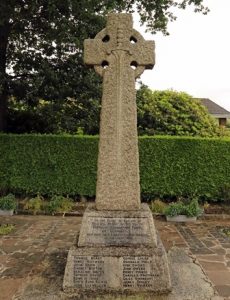
The Great War, 1914-1918
Walter Thomas Berry, Private, 31062, Royal Welsh Fusiliers. Walter was born in Whittington, Gloucester in 1897, the son of Henry and Mary Ann Berry. By 1911 the family was residing at Holly Cottage, Llandrindod Wells. Walter worked as a Jeweller’s Assistant for H. Leckenby, in Middleton Street prior to the war. He enlisted into the Royal Army Medical Corps at Llandrindod on 17 May 1915, but on 2 June 1915 was transferred to the 3rd Battalion, Royal Welsh Fusiliers. On 15 October 1915 he embarked for the Mediterranean, to join the 8th Battalion, Royal Welsh Fusiliers. The battalion was at Gallipoli, attached to 40 Brigade, 13th (Western) Division, and Walter disembarked at Gallipoli on 27 October, joining the battalion in the trenches at Scimitar Hill. Although the main fighting had by now died down, conditions were terrible, with sickness and disease prolific among the troops. Walter had been on Gallipoli for little under a month, when he became ill and was invalided aboard the Hospital Ship Nevassa. He died of diphtheria aboard the ship on 4 December 1915, aged 19 and was buried at sea. Walter is commemorated on the Helles Memorial, Gallipoli.
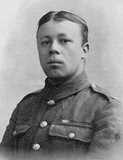
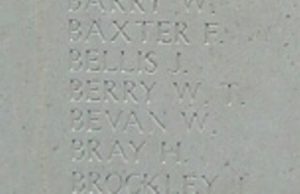
Henry Botwood, Private, 17969, King’s Shropshire Light Infantry. Henry was the son of Thomas Botwood and Frances Botwood (nee Brick), of Crossway, Penybont Station. He enlisted at Knighton into the King’s Shropshire Light Infantry soon after the start of war. He embarked for France early in 1916 and was posted to the 1st Battalion, King’s Shropshire Light Infantry, which was attached to 16 Brigade, 6th Division, at Ypres. The Division was holding the Canal Bank sector, and its infantry battalions were carrying out the usual routine of trench rotation, four days in the front line, four in support and four in reserve. The Division moved slightly south, to the Railway Wood sector in February, before enjoying a short break in the Calais area in the middle of March, before moving back to the Canal Bank sector. On 5 June 1916 the 1st KSLI moved from E Camp into the front and support trenches on the Canal Bank to begin another routine spell in the line. Over the coming days the battalion’s positions suffered regular artillery barrages from the Germans, and during one such barrage, Henry was wounded. He was evacuated to a Casualty Clearing Station at Poperinghe, where he died of his wounds on 11 June 1916, aged 18. He is buried in Poperinghe New Military Cemetery, Belgium.
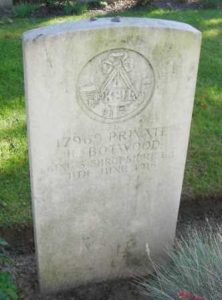
John Brick, Private, 34387, King’s Shropshire Light Infantry. John was the son of John and Anne Brick, of Newhouse, Llanbister, Penybont Station, Radnor. He enlisted at Knighton into the King’s Shropshire Light Infantry, and after training at Bush Camp, Pembroke Dock was posted to France early in 1918, joining the 1st Battalion, King’s Shropshire Light Infantry, which was attached to 16 Brigade, 6th Division. The Division had been in France since 10 September 1914 and had taken part in most of the major battles of the war. John probably joined the battalion in billets at Bailleulval in January 1918, while the 6th Division was holding a section of line east of Bapaume, between Demicourt and Boursies. The battalion then moved back into the line, carrying out the usual system of trench rotation over the coming weeks. The troops in the front line were uneasy during this period, as they were aware of a lot of activity behind the German lines, and it was obvious that an offensive was coming, then at dawn on 21 March 1918 the Germans launched a massive offensive, along the front running from Croisilles down to La Fère. The 1st KSLI was in the front line when the Germans struck, and met them with ferocious firepower, inflicting severe casualties upon them. Heavy fighting raged over the coming days, as the battered British began withdrawing under the weight of the German pressure. The 6th Division was relieved on 24 March and moved to Ypres to rest, taking over positions at Frezenberg. On 9 April the Germans launched a second offensive, along the Lys, and the Division stood to, expecting to face another German attack, but the fighting raged to the south and, apart from constant shelling, Ypres remained relatively quiet. The Division remained here over the coming months, based around the ramparts of the ruined city. John was killed in action during the battalions last spell in the line at Ypres, as the Division was preparing to move south, on 14 August 1918. He was 19 years old, and is buried at Esquelbecq Military Cemetery, France. John is also commemorated on the KSLI memorial at St. John’s Church at Pembroke Dock.
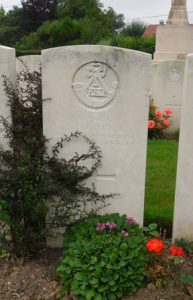
Garnet Bufton, Gunner, 74067, Royal Garrison Artillery. Garnet was the son of Edward and Sarah Bufton, of Penybont. He was educated at Llandrindod Intermediate School, before joining the Civil Service and moved to London to work for the GPO. Garnet married Edith Alice Emmett at St. Bartholomew’s Church, East Ham on 4 July 1915. On 17 December 1915 Garnet enlisted at Leyton, Essex into the Royal Garrison Artillery, and was posted to No 1 Depot at Portsmouth, where he trained as a signaller. On 17 October 1917 Garnet was drafted to France, joining the 218th Siege Battery, Royal Garrison Artillery, in the Ypres Salient. Garnet was killed in action at Ypres on 5 May 1918, probably from German counter-battery fire. The 26-year-old is buried in Brandhoek New Military Cemetery No.3, Belgium.
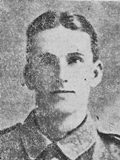
Benjamin Davies, Private, 41265, South Wales Borderers. Benjamin was the son of Evan Davies and Margaret Harriet Davies (nee Bage), of Woodside Cottage, Penybont Station. He enlisted into the Welsh Regiment, but after being drafted to France in the summer of 1917, was transferred to the 12th Battalion, South Wales Borderers, which was attached to 119 Brigade, 40th (Bantam) Division. He probably joined the battalion at Gonnelieu, where the Division was holding a section of front line facing the mighty Hindenburg Line. The infantry battalions of the division were carrying out the usual routine of trench rotation, in what was at the time a relatively peaceful sector. On 7 October the battalion moved to billets in Doingt, and the entire division moved to Gouy-en-Artois, to carry out a system of training, in preparation for the forthcoming Battle of Cambrai. The 40th Division remained here for several weeks before moving back to the battle area, and during the night of 21 November moved into positions at Doignies, before advancing to Graincourt, in readiness to launch an assault on Bourlon Wood. At dawn on 23 November 1917, supported by tanks, 119 Brigade assaulted Bourlon Wood, the 12th SWB on the left in conjunction with the 19th RWF. The 12th SWB met heavy resistance, so the 18th Welsh were sent forward to assist. Heavy fighting raged throughout the day, and many casualties were suffered. Benjamin was killed in action at some time during that first day of the battle, 23 November 1917. The 19-year-old has no known grave and is commemorated on the Cambrai Memorial, Louverval, France. He is also commemorated on the Rhayader war memorial.
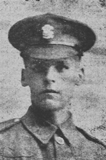
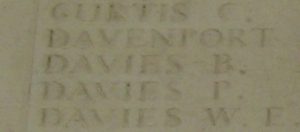
Evan Thomas Davies, Private, 51663, Cheshire Regiment. Evan was born at Faldlace Farm, Llanyre in 1891, the son of Evan and Sarah Jane Davies. He worked as a waggoner for David Mills at Newbridge-on-Wye prior to the war and enlisted at Knighton into the King’s Shropshire Light Infantry on 31 May 1917. He was posted to Pembroke Dock for training with the 3rd Battalion, KSLI and after training embarked at Southampton for France on 19 October 1917. Upon arrival in France, he briefly joined the 5th Battalion, KSLI, but within days was transferred to the 15th Battalion, Cheshire Regiment. The battalion was attached to 105 Brigade, 35th Division, and was at Ypres, taking part in the Battle of Passchendaele. By the spring of 1918 the division was back on the Somme, and fought at the First Battle of Bapaume, during the German Offensive, and took part in a fighting withdrawal to Bouzincourt, where it was relieved by the 38th (Welsh) Division. The division remained in the area over the coming weeks, and after a spell in reserve moved back into the front to the left of the 38th Division. Evan was badly wounded in the thigh during an assault on Aveluy Wood on 1 June 1918. He was evacuated to the 107th Field Ambulance before being sent to the Base Hospital at Le Treport where he died of his wounds on 5 June 1918, aged 26. Evan is buried in Mont Huon Military Cemetery, Le Treport, France. He is also commemorated on the Newbridge-on-Wye, Llanyre and Nantmel War Memorials.
Edward Aaron Hope, Corporal, 148131, Machine Gun Corps. Edward was born at Abbeycwmhir in 1897, the son of Aaron and Elizabeth Ann Hope. By 1901 the family had moved to Wernddu Cottage, Nantmel and a further three daughters and one other son were born, before the family moved again, to 5, Brookland Road, Llandrindod Wells. He enlisted at Knighton into the Herefordshire Regiment but, unlike his two brothers, was posted to France, joining the 38th Battalion, Machine Gun Corps, which was attached to the 38th (Welsh) Division. He probably joined up with the division after its assault on Mametz Wood in July 1916 and possibly took part in the divisions assault on the Pilckem Ridge, during the opening of the Third Battle of Ypres, on 31 July 1917. The division wintered in the Armentieres sector, before being moved to positions north of Albert, on the Somme, at the end of March 1918, and remained there until launching their offensive across the flooded Ancre valley on 21 August 1918. Edward would have been a member of a machine-gun crew covering the river crossings, which the assaulting troops waded through during the opening of the offensive that morning. Edward was killed in action on the following day, 22 August 1918, whilst more troops were crossing the Ancre. He was 21 years old and is buried in Varennes Military Cemetery, France. Edward is one of three Hope brothers who fell during the war, but is the only one named on the Penybont memorial, however all of the brothers are commemorated on the Llandrindod Wells memorial.
David James Jones, Private, M/427214, Royal Army Service Corps. David was the son of David and Jane Jones, of Glandwr Cottage, Penybont Station. He had married Sarah Lewis on 14 December 1908. Sadly, Sarah had died soon after the birth of their daughter, Elsie Lily Jones, on 7 March 1909. David worked as a railway platelayer prior to the war and enlisted into the Railway Troops Depot, Royal Engineers at Knighton on 24 January 1916. He served with the Royal Engineers until October 1918 when he was transferred to the Motor Transport, Royal Army Service Corps, but took ill and died at Brooklyn V.A.D. Hospital, Sydenham, on 22 November 1918, aged 31. His remains were brought home and he was buried in St. Padarn’s Churchyard, Llandrindod Wells. David is not commemorated on the Penybont war memorial, but is commemorated at Nantmel and on the Rhayader War Memorial.
William Trevor Jones, Private, 260463, Gloucestershire Regiment. William was born in Liverpool, the son of Reverend Owen Daniel Jones and Annie Edith Jones (nee Hughes). His parents were from Welshpool, but had lived in several places, from Bedwellty, Newtown, and Liverpool, before Williams’s mother died in 1903. His father then remarried and moved the family to Newport, Mon by 1911, but at some time prior to the war was living at The Manse, Penybont. William enlisted at Cardiff into the Monmouthshire Regiment, and after completing his training was posted to France in the summer of 1917, where he was transferred to the 12th Battalion, Gloucestershire Regiment, which was attached to 95 Brigade, 5th Division. The 12th Gloucester’s had been virtually annihilated during the Battle of Arras, and was rebuilding prior to the Division moving to the Ypres Salient. The 5th Division did not go back into action until moving into positions near Polygon Wood on the night of 2/3 October, then attacked at Broodeseinde on 4 October 1917, assisted by a single tank. The initial attack was successful, with 95 Brigade advancing almost 500 yards, but heavy casualties had been suffered from German artillery fire. William was killed in action at some time during the days fighting. The 18-year-old has no known grave and is commemorated on the Tyne Cot Memorial, Belgium. He is not commemorated on the Penybont war memorial.
David Evan Lewis, Private, 21404, King’s Shropshire Light Infantry. David was the son of Evan and Ann Lewis, of Red House, Penybont Station. He was a carpenter, and married Selena Price in 1907. The couple lived at Mills Cottage, Penybont Station, where their two children were born, before moving to 1, Boundary Terrace, Llandrindod Wells. David enlisted at Llandrindod Wells into the 6th Battalion, King’s Shropshire Light Infantry soon after the outbreak of war. The battalion was formed at Shrewsbury before joining 60 Brigade, 20th (Light) Division at Aldershot, then moved to Larkhill, Salisbury Plain before landing in France on 22 July 1915. The Division moved to the Fleurbaix Sector for trench familiarisation and training. When the Battle of Loos was launched on 25 September 1915 the Division fought a diversionary attack towards Fromelles. Later that year it moved north, and fought at the Battle of Mount Sorrel alongside the Canadian Corps. The Division then moved south to the Somme on 25 July, in order to take part in the great Somme offensive and on 29 July relieved the 38th (Welsh) Division in the line at Hébuterne. The ground was still littered with the dead from the 1 July fighting and the Division spent most of its first days on the Somme removing and burying bodies. During August the Division moved slightly south, taking over the line which ran from the Guillemont-Montauban road just west of Guillemont to a point just south of the south east corner of Delville Wood and began to prepare to launch an offensive here. Conditions were terrible, with constant artillery fire and poor weather making preparation for the attack difficult, so it was postponed several times and the attack did not take place until September. The Division then saw heavy fighting during the Battle of Flers-Courcelette, then at the ensuing Battles of Morval and Le Transloy, before wintering on the Somme. When the Germans withdrew to the Hindenburg Line in February 1917 the Division was among those that followed up their withdrawal. David was killed in action near Morval on 3 March 1917, when a shell crashed into his position. The 34-year-old has no known grave and is commemorated on the Thiepval Memorial, France.
John Hughes Llewellyn, Private, 285283, Welsh Regiment. John was the foster son of James and Mary Davies, of The Nursery, Penybont. He worked as a tree feller prior to the war. John enlisted at Llandrindod Wells into the Herefordshire Regiment, but after completing his training was posted to France in the summer of 1917, where he was transferred to the 10th Battalion, Welsh Regiment, which was at Ypres attached to 114 Brigade, 38th (Welsh) Division. John joined the 10th Welsh on the Canal Bank positions at Boesinghe, north of Ypres, where the Division was preparing to launch its assault on the Pilckem Ridge. The attack was part of the opening of the Third Battle of Ypres, and was launched on 31 July 1917. The Division managed to attain its objective of the position known as Iron Cross and reached the Steenbeek, where it dug in, in preparation for the advance to be carried towards Langemarck. The Division had suffered heavy losses, with the 10th Welsh alone losing 6 officers and 151 other ranks during that first day alone, but remained in the line to support the ongoing assault on Langemarck, before being relieved in the middle of September and moving to the Boutillerie sub-sector near Fleurbaix. The infantry battalions of the division then began the usual routine of trench rotation, whilst being reinforced by drafts of men, over the coming weeks. On 26 October the 10th Welsh carried out a trench raid in their new sector, but the raiding party got lost and failed to reach its objective. John was wounded during the raid, and evacuated back to the nearest Casualty Clearing Station at Éstaires, where he died of his wounds on 28 October 1917, aged 21. He is buried in Éstaires Communal Cemetery Extension, France.
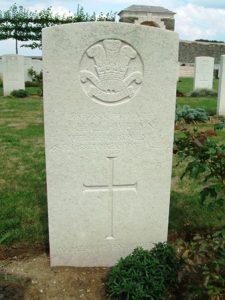
George Lucas, Private, 22206, King’s Shropshire Light Infantry. George was the son of William and Sarah Ann Lucas, of Baynham Farm, Knighton. He worked on Dolau Farm, Penybont prior to the war. George enlisted into the King’s Shropshire Light Infantry at Knighton, and after completing his training was posted to France at some time late in 1916, joining the the 7th Battalion, King’s Shropshire Light Infantry, which was attached to 8 Brigade, 3rd Division. He was soon transferred to the 1st Battalion, King’s Shropshire Light Infantry, which was attached to 16 Brigade, 6th Division. George probably joined the battalion in time to take part in the Somme offensive, where the Division fought at the Battle of Flers-Courcelette, the Battle of Morval and the Battle of Le Transloy. The following year saw the Division at Arras, where it fought at the Battle of Hill 70., and remained in positions at Loos, near Hulluch, over the summer, before moving to positions at Lens in September. The Division then went out of the line to train and prepare to take part in the Battle of Cambrai later in the year, moving to positions near Dessart Wood by 17 November, before taking over positions at Villers-Plouich and on 20 November 1917 the division launched its first offensive of the battle, against the Hindenburg Line, capturing a lock gate over the St. Quentin Canal at Marcoing. The 1st KSLI was then relieved and rested before moving back into the front line on 30 November to continue the offensive, with fighting raging along the Cambrai line. On 1 December 1917 the 1st KSLI launched their assault on the Quentin Ridge, west of Gonnelieu, suffering terrible casualties from machine-gun fire. George was killed in action during the days fighting. The 25-year-old has no known grave and is commemorated on the Cambrai Memorial, Louverval, France.
John Reginald Mills, Private, 25114, Duke of Wellington’s (West Riding Regiment). John was born on 20 December 1897, the son of John and Martha Elizabeth Mills, of Baileymawr Farm, Penybont. He worked as a Chauffeur for Captain Walsh at Llwynbarried Hall prior to the war. John enlisted into the army at Knighton on 20 September 1916, stating his preference to join the Army Service Corps as a Motor Transport driver, and was posted to their depot at Grove Park. On 31 October John was compulsorily transferred to the 88th Battalion, Training Reserve at Blythe. On 14 May 1917 John embarked at Folkestone for France and two weeks later was posted to the 2/6th Battalion, Duke of Wellington’s (West Riding Regiment), which was attached to 186 Brigade, 62nd (West Riding) Division, in and was in a rest camp at Achiet-le-Petit. At the end of June, the battalion moved back into the line at Noreuil, in the Bullecourt Sector, to begin a routine tour in the front-line trenches, and remained in the area over the months leading up to the Cambrai offensive, before moving to positions at Moeuvres. The Battle of Cambrai opened at dawn on 20 November 1917, and to the west of Flesquières, the 62nd (2nd West Riding) Division advanced through Havrincourt and Graincourt to within reach of the woods on Bourlon Ridge. The Division was then relieved by the 40th Division, which launched a costly assault on Bourlon Wood over the coming days. On 25 November the Division relieved the battered 40th Division in Bourlon Wood and on 27 November 1917 launched another assault, towards the Railway Lines. John was killed in action during this attack that day, probably during a heavy German artillery bombardment in the afternoon. The 19-year-old has no known grave and is commemorated on the Cambrai Memorial, Louverval, France.
Ivor Owens, Private, 239043, Herefordshire Regiment. Ivor and his twin brother Howard were born on 7 May 1898, the sons of John Whittal Owens and Margaret Owens (nee Rogers), of Llanevan Farm, Llanfihangel Nant Melan. The brothers moved to Presteigne, where they were educated. Despite taking the case to a Military Appeals Court, Ivor was drafted into the Herefordshire Regiment in 1917 along with his brother Howard, and the twins were sent to Park Hall Camp at Oswestry for training. Within weeks, Howard contracted influenza and was hospitalised in Oswestry Military Hospital. As he was recovering, Ivor took ill and he sadly died in the hospital of influenza on 25 February 1917, aged just 18. Ivor’s remains were brought home for burial in St. Tegla’s Churchyard, Llandegley. His brother Howard later served in France, but survived the war.
John Rees Owens, Private, 355456, Royal Welsh Fusiliers. John was the son of Richard James Owens and Mary Owens, of Llwyn, Penybont Station. He enlisted into the 3/1st Battalion, Montgomeryshire Yeomanry at Welshpool on 15 December 1915 and was posted to the camp at Gobowen for training. On 10 January 1917 John embarked for Egypt, joining the 1st Battalion, Montgomeryshire Yeomanry, but on 4 March 1917 the battalion merged with the Welsh Horse Yeomanry at Helmia forming the 25th (Montgomery & Welsh Horse Yeomanry) Battalion, Royal Welsh Fusiliers, in the newly formed 231 Brigade, 74th (Yeomanry) Division. The Division then fought during the Palestinian Campaign, at the Second and Third Battles of Gaza and during the capture of Jerusalem. Due to the terrible casualties suffered by the British on the Western Front in March and April 1918 the Division was recalled to France, and arrived at Marseilles during May 1918 and moved to the St. Hilaire area. The Division then took over the St. Floris sector where it remained until moving south to the Somme sector at the end of August, to take part in the great offensive which had been launched on 21 August 1918. During the first two weeks of September the Division advanced towards the Hindenburg Line, and by 18 September was facing the outer defences of the Hindenburg Line, near Lempire and Ronssoy. On 21 September 1918 the Division launched an assault against the German defences, but suffered heavy casualties at Benjamin Post and Gillemont Farm. John was killed in action during the days fighting. The 21-year-old has no known grave and is commemorated on the Vis-en-Artois Memorial, Haucourt, France.
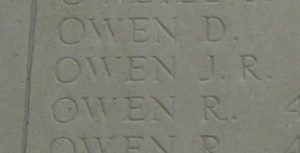
Basil Harry Raymond Prince, Private, 29802, South Wales Borderers. Basil, known as Harry, was born in Herefordshire in 1890, the son of Daniel Prince and Mary Ann Prince (nee Stokes). By 1911 the family had moved to Pales Villa, Penybont, Radnor. Harry worked in South Wales prior to the war and enlisted at Tonyrefail into the 6th Battalion, South Wales Borderers. The battalion had been in France since 25 September 1915 and was the Pioneer Battalion to the 25th Division. The Division moved to Le Bizet for trench initiation, and the 6th SWB began work around Oosthove Farm. After a short spell at Dickebusch, the Division moved to Neuville St. Vaast, and helped defend Vimy Ridge against a German attack in May 1916. The Division then moved to the Warloy area and attacked on 3 July near Thiepval. The Division fought throughout the Battle of the Somme, and then moved back to the Ploegsteert sector, where it held the line for the months leading up the Battle of Messines in June 1917. After fighting at Messines, the Division moved north, and fought at Pilckem, before moving south again, taking up positions around Bullecourt in reserve. Here the Division was used to reinforce the badly depleted British units that were hit in the area by the German Spring Offensive, which had been launched on 21 March 1918, and the 6th SWB suffered heavy casualties here before the Division was relieved and moved north to Flanders on the night of 30 March, taking up positions at Ploegsteert again, where it received reinforcements, and rebuilt. Unfortunately, on 9 April the Germans launched the second phase of their offensive here, along the Lys Valley, and the Division was caught up in the terrible fighting which followed. The 6th SWB was in the Catacombs at Ploegsteert that morning and was ordered forward, together with the 3rd Field Company, RE, to form a defensive flank for the 25th Division. The Germans then broke through at Ploegsteert village and the battalion was forced to withdraw, coming under heavy fire. Fighting raged over the coming days, as the line was pushed back by the Germans towards Neuve Eglise. The 6th SWB alone suffered 386 casualties, almost half its strength, during four days of ferocious fighting until it was relieved. According to the battalion war diary, Harry had been posted as killed in action, on 10 April 1918, at the height of the fighting. He is officially listed as being killed in action on 15 April 1918, aged 26, but the correct date is most likely 10 April. Harry has no known grave and is commemorated on the Ploegsteert Memorial, Belgium.
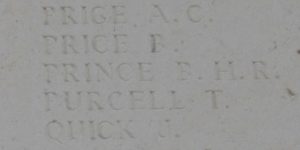
Samuel Charles Pritchard, Private, 25621, Grenadier Guards. Samuel was the son of William and Fortune Pritchard, of Hill House, Penybont Station. He worked as a postman prior to enlisting at Knighton into the Grenadier Guards and was posted to France in 1916, joining the 2nd Battalion, Grenadier Guards, which was attached to the 1st Guards Brigade, Guards Division. During July 1916 the Division moved from the Loos area to the Somme, and took part in the Battle of Flers-Courcelette, the first time that tanks were used in warfare. The division then took part in the Battle of Morval, capturing Lesbœufs Village. It remained here for the winter, which was particularly harsh. Samuel had taken ill during this time and died of pneumonia on 14 February 1917, aged 23. He is buried in Grove Town Cemetery, Méaulte, France. Samuel is also commemorated on the Rhayader War Memorial.
Giles James Swancott, Private, 54431, Royal Welsh Fusiliers. Giles was the son of Richard and Louisa Swancott, of Cwmcwtta, Llanfair Waterdine, Knighton. He worked at Penybont prior to the war. Giles enlisted at Knighton into the 3/1st Battalion, Montgomeryshire Yeomanry, and was posted to Oswestry for training. Upon completing his training, Giles was posted to France in the summer of 1916, along with a number of other Montgomery Yeomanry men, joining the 10th Battalion, Royal Welsh Fusiliers, which was attached to 76 Brigade, 3rd Division. The Division had suffered terrible casualties during its assault on Delville Wood, and had been moved to the Loos sector to rebuild. Giles joined the 10th RWF in camp at Liettres on 26 September 1916, among a draft of 87 men. During the first week of October the Division began moving back to the Somme sector, taking over a section of the front line at Bertrancourt. On 12 November the 10th RWF moved back into the front line facing Serre, and on the following morning, 13 November 1916, launched an assault on the strongly defended German trenches, advancing from Matthew and Mark Copse, and the battalion soon reached the village of Serre. Fighting raged throughout the day, with the RWF out-running the adjacent battalions, and becoming embroiled in desperate fighting. Giles was among almost 300 casualties suffered by the battalion during the day, being killed in action near Serre village. The 21-year-old has no known grave and is commemorated on the Thiepval Memorial, France.

James Tunley, Private, 27825, Border Regiment. James was the son of Nathaniel and Harriet Tunley of Pentre, Llandrindod Wells. He had been a labourer prior to gaining work on the golf links at Llandrindod and then at the Robin Hood Club, Birmingham. James enlisted at Llandrindod Wells into the Herefordshire Regiment, and after completing his training was posted to France at some time in 1916, originally destined for a battalion of the King’s Shropshire Light Infantry. He was instead transferred to the 11th Battalion, Border Regiment, known as the Lonsdale’s, which was attached to 97 Brigade, 32nd Division. The Division had moved to France at the end of December 1915, and the following year took part in the opening of the Somme Offensive, and then fought at the Battle of Bazentin, the Battle of the Ancre and the resulting Operations on the Ancre. The Division remained in the sector over the winter, and in March 1917 followed the German Retreat to the Hindenburg Line, moving to the ruins of Rouvroy by 17 March. The Germans continued to withdraw over the coming days, and the 32nd Division moved forwards, passing the ruined villages of Herley and Nesle and by 30 March the Division was facing the strongly defended village of Savy. On the following night the Lonsdale’s moved into position with orders to assault the village of Savy, and at 05.00, after a tot of rum for each man, the battalion launched its assault on the village, following a rolling artillery barrage. Within 90 minutes the battalion had taken the village and began consolidating its gains. James was killed in action during the days fighting. The 31-year-old is buried in Savy British Cemetery, France.
Harry Kemp Vickery, Private, G/21719, The Queen’s (Royal West Surrey Regiment). Harry was born in Barnstaple in 1886, the son of John and Mary Vickery. His father was a schoolmaster, and the family had moved around the country over the coming years, moving to Medway by 1891, then to Abertillery by 1901 and Monkton Combe by 1911. The family then moved to Llandegley, where Harry’s father had taken the position of headmaster of Llandegley School. Harry enlisted at Brighton into The Queen’s (Royal West Surrey Regiment) soon after the outbreak of war, and was posted to the 10th Battalion, The Queen’s. The battalion joined 124 Brigade, 41st Division at Stanhope Lines, Aldershot, and on 6 May 1916 landed at Le Havre, before the entire division moved to the Outtersteene area and then took over the Ploegsteert sector for trench initiation. During August 1916 the division began to move to the Somme sector and by 14 September had moved forward to trenches east of Delville Wood, and took part in the Battle of Flers-Courcelette. The Division remained in the line, pushing on to Courcelette over the next few days before coming out for a rest and re-fit at Dernancourt. By 6 October the 10th Queen’s had moved back into the front line and on 7 October 1916 took part in heavy fighting during the Battle of Le Transloy. Harry was killed in action during the day. The 30-year-old has no known grave and is commemorated on the Thiepval Memorial, France.
World War Two, 1939-1945
Hugh Ferguson Bryson, Flight Sergeant, 1315187, Royal Air Force Volunteer Reserve. Hugh was born on 3 December 1921, the son of Robert and Jeanie Bryson, of Baileymawr, Penybont. His father was a Land Agent. Hugh had enlisted into the Royal Air Force Volunteer Reserve following the outbreak of war, and after completing his training and qualifying as a pilot was posted to 458 Squadron, RAF. The squadron was a Royal Australian Air Force Squadron, equipped with the Vickers Wellington and joined RAF Bomber Command in 1941, taking part in raids over occupied Europe. At the end of January 1942, the squadron was withdrawn from Bomber Command to serve in the Middle East, becoming a Maritime unit and carrying out anti-shipping operations in the Mediterranean. On 2 November 1943, Hugh was aboard a Wellington XIII, Serial HZ874, which took off from Sidi Amor on an anti-submarine patrol. When over the sea one engine of the Wellington caught fire, and Hugh was forced to ditch the stricken aircraft into the sea. The Wellington unfortunately broke up as soon as it hit the water, and sank. Hugh and his fellow pilot, Flying Officer Howie, were drowned, while the rest of the crew escaped. Hugh was 21-years-old when he was lost when his aircraft sunk that day, and is commemorated on the Malta Memorial, Malta.
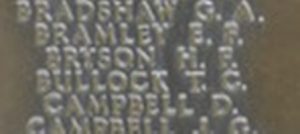
James William Cox, Lance Corporal, 7015058, Pioneer Corps. James was the husband of Violet May Cox (nee Price), of Penybont. He served with the Pioneer Corps during the war, and from June 1944 had landed in Normandy, taking part in the drive out of the Normandy beach-head through northern France into Belgium and Holland. Little else is known, but James died in Holland on 5 November 1944, aged 32, and is buried in Uden War Cemetery, Netherlands.
Edward Ingram, Guardsman, 2736377, Welsh Guards. Edward was born on 14 June 1915, the son of Thomas and Ada Ingram, of Nantmel. He married Sylvia Alice Davies in 1941. Edward worked as a gardener prior to enlisting into the Welsh Guards and was posted to the 2nd Battalion, Welsh Guards. The battalion had been formed on 18 May 1939 and embarked for France on 21 May 1940 to cover the withdrawal from Boulogne and formed a perimeter around the docks where it was attacked that same night by German infantry supported with Panzers. The battalion lost over 450 men during heavy fighting in Boulogne and rebuilt in the Codford area. Edward died during this period, on 25 August 1941, aged 26. His remains were brought home and he was buried in St. Cynllo’s Churchyard, Nantmel. His widow, Sylvia, later resided at Cwmfelinfach, Monmouthshire. The inscription at the base of Edward’s grave reads: “DEARER STILL AS YEARS DEPART HIS MEMORY LIVES WITHIN OUR HEARTS”.
Robert David Miller, Master, Merchant Navy. Robert was born in Barry, Glamorgan in 1905, the son of Robert Bushell Miller and Edith Alice Miller. He entered the Merchant Navy as a young man, and at the age of 21 had qualified as First Mate. Following the outbreak of war, Robert was serving as Master of the MV Canadian Star, a refrigerated cargo ship. He married Doris Mary Rice, of Windyridge, Penybont, at Liverpool in 1942 whilst on shore leave. On 18 March 1943, Canadian Star was sailing with Convoy HX-229 en-route from Sydney to Liverpool, carrying a cargo of refrigerated foodstuffs, when the Convoy came under attack by the German submarine U-221. The submarine sunk one of the other merchant vessels in the convoy before firing a spread of torpedoes at Canadian Star, two of which struck her in the engine room. Robert calmly took command of the dire situation his ship was in, and managed to get some of the ship’s lifeboats off, in heavy seas, before his ship sank. Robert was 38 years old when he was drowned during the sinking of Canadian Star that day. The 38-year-old has no known grave and is commemorated on the Tower Hill Memorial, London. He had already been awarded the King’s Commendation for Brave Conduct, but was also posthumously awarded the Lloyd’s War Medal for Bravery at Sea for his actions during the sinking of his ship.
Ivor James Morris, Flight Sergeant, 1430151, Royal Air Force Volunteer Reserve. Ivor was the son of James Leonard Morris and Clara Ann Morris (nee Stephens), of Llandrindod Wells. He enlisted into the Royal Air Force Volunteer Reserve, and after training as an Air Gunner was posted to 207 Squadron, RAF, which was a heavy bomber Squadron, attached to RAF Bomber Command. The Squadron was originally based at RAF Waddington, equipped with the Avro Manchester, and later moved to RAF Bottesford, where it re-equipped with the improved Avro Lancaster in March 1942. The squadron relocated to RAF Langar on 21 September, and then in October 1943 moved to the newly built RAF Spilsby bomber station. On the night of 28 July 1944, Ivor took off from RAF Spilsby aboard Avro Lancaster III, Serial ND872, which was part of a force despatched to bomb Stuttgart. During the early hours of the following morning, 29 July 1944, the Lancaster crashed just over a mile northwest of Bebenhausen, killing all her crew of seven men. Ivor was 21 years old when he was killed during the crash of his aircraft that morning. He was originally buried alongside his fellow crewmen in Bebenhausen Cemetery, but on 20 August 1948 the remains of the seven men were re-interred in Durnbach War Cemetery, Germany.
Leonard Albert Arthur Smith, Stoker 2nd Class, D/KX 114320, Royal Navy. Leonard was born at Penybont on 20 July 1920, the son of John Albert Smith and Margaret Alice Smith (nee Brick). By 1939 the family was residing at Meriden, Warwickshire, where Leonard was working as an apprentice plumber. He married Muriel Checkley at Birmingham in 1940. Leonard enlisted into the Royal Navy following the outbreak of war, and was posted aboard the light-cruiser HMS Neptune. She had begun the war patrolling in the South Atlantic, before being transferred to the Mediterranean, and took part in the Battle of Calabria, against the Italian fleet, on 9 July 1940. Suffering heavy damage, Neptune underwent repairs before being despatched to lead Force K, a raiding squadron of cruisers, in 1941, whose task was to intercept and destroy German and Italian convoys en-route to Libya. On 18 December 1941, Force K was despatched to intercept a convoy bound for Tripoli, and on the night of 19/20 December, Neptune, leading the line, steamed into an Italian minefield, and struck two mines. The ship shuddered to a halt and began to reverse out of the minefield, but struck a third mine, losing her propellors. The remainder of Force K had also suffered damage from the mines and were unable to aid the stricken Neptune, which drifted into a fourth mine, before capsizing with the loss of 737 lives. Leonard was 20 years old when he was drowned in the sinking of Neptune on 19 December 1941. He has no known grave and is commemorated on the Plymouth Naval Memorial, Devon.
Raymond Tudor Thomas, Air Mechanic 2nd Class, L/FX 762609, Royal Navy. Raymond was born on 30 May 1928, the son of Tudor Jones Thomas and Constance Mary Thomas (nee Waldron), of 4, Railway Terrace, Penybont Station. He enlisted into the Royal Navy at some time towards the end of the war, and was posted to HMS Seruwa, the RN base at Ratmalana, Ceylon. On 6 June 1946 Raymond was swimming in Lunawa Lagoon, when he got into difficulties and drowned. The remains of the 18-year-old were recovered and he was buried in Colombo (Liveramentu) Cemetery, Sri Lanka.
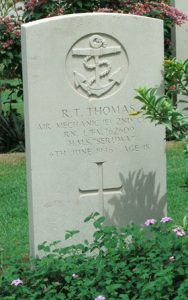
Alfred Thomas Williams. Alfred cannot presently be identified, but a 17-year-old man of that name, of Trelowcoed Mill, died in Radnorshire on 13 September 1942, and is buried in St. Padarn’s Churchyard, Llanbadarn Fawr.
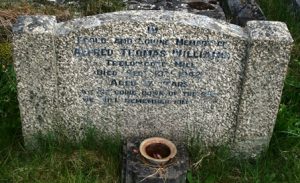
William Cyril Williams, Sergeant, 1410983, Royal Air Force Volunteer Reserve. William was the son of John and Sarah Williams, of Cross Gates, Llandrindod Wells. He enlisted into the Royal Air Force Volunteer Reserve and was posted to 1660, Heavy Conversion Unit, at RAF Swinderby, for training on the Avro Lancaster. On 6 July 1943 William was flying aboard Lancaster I, Serial R5736, when the aircraft crashed into the side of a hill near Llangernyw, 12 miles WNW of Denbigh, killing all six men aboard. William was 21 years old when he died that day and his remains were buried in St. Michael’s Churchyard, Beguildy.